[ad_1]
Imagine the webinar you spent hours preparing for doesn’t have enough participants show up for it just because you didn’t know the best day and time to host a webinar!
As a webinar host, one of your main goals is to get as many people to attend your webinar as possible. While the quality of the webinar content and your efforts to promote it play the biggest roles in making this happen, selecting the best day and time for a webinar is important too.
In this post, you’ll learn how to choose the best day and time to hold a webinar to maximize your attendance rates. Here’s what we’ll cover:
We’ll also introduce you to our product, eWebinar, an automated webinar platform with average attendance rates double the industry average for live webinars. Join our demo to learn more.
Is there a best day and time to host a webinar?
The short answer is yes. While there is no one-size-fits-all answer to this question, there is ample research to suggest that certain days and times are better for webinar attendance than others. (Skip ahead to find out what those are.)
When considering the best times to host webinars, it’s important to look at the available research on the topic. However, the only things that matter in the end are the availability and preferences of your target audience, including factors like time zones, work hours, and personal commitments.
Why selecting the best webinar time is important
Choosing the best time for your webinar is crucial for three reasons:
- Attendance rate: A well-timed webinar can significantly increase the number of its attendees, which is a key measure of any successful webinar and critical for lead generation.
- Engagement level: When your audience is more available and alert, they are more likely to participate in the experience, ask questions, and stay engaged.
- Conversion rate: A higher attendance rate often leads to a higher conversion rate, which means more sales or sign-ups for your product or service.
What’s the best day to host a webinar?
Research has shown that the best day of the week to host a live webinar is on either Wednesday or Thursday, followed by a close third, Tuesday.
According to a study by GoToWebinar, these three days in the middle of the week account for 77% of all webinars and experience the highest attendance rates. Mondays and Fridays are less ideal than mid-week, as people may be less engaged or busy with other priorities at the beginning or end of the workweek.
What’s the best time to host a webinar?
According to research conducted by ON24, the best time of day to host a webinar is either late morning at 11 AM or early afternoon at 2 PM — in the audience’s local time zone. These time slots let webinar attendees join during work hours, but not their lunch hour.

It’s essential to consider the time zones of your target audience. For example, if you’re hosting a webinar for attendees in the United States, you might choose 11 AM PST, which translates to 2 PM ET, ensuring reach a broader audience across the country.
Keep in mind that the above recommended days and times are for business-related webinars. For B2C webinars, you may need to consider times in the evenings and on weekends to reach your target audience.
What is the best time to host a global webinar?
The truth is there is no good time to host a global webinar. The best way to reach a global audience is through webinar automation. (The alternative is to host multiple live webinars in different regions around the world.)
Keep reading to learn more…
How to maximize your attendance rate with automated webinars
The elephant in the room when it comes to choosing the best day and time to host a live event is that no matter what you decide, you will never be able to accommodate everyone’s schedule, which means you will never be able to reach all potential attendees.
Our product, eWebinar, was specifically designed to solve this problem. We turn any pre-recorded video into an engaging, interactive webinar that you can set on a recurring schedule or make available on demand, so your webinars are available when your customers are, in any time zone.
To illustrate, the average webinar attendance rate across all our customers is 65%. That’s over 60% higher than the industry average for live webinars, which is roughly 40%. Many of our customers report regular attendance rates of 80% to 90%.
So how do we do it?
eWebinar offers three key scheduling features that make this possible:
1. Just-in-time or on-demand sessions
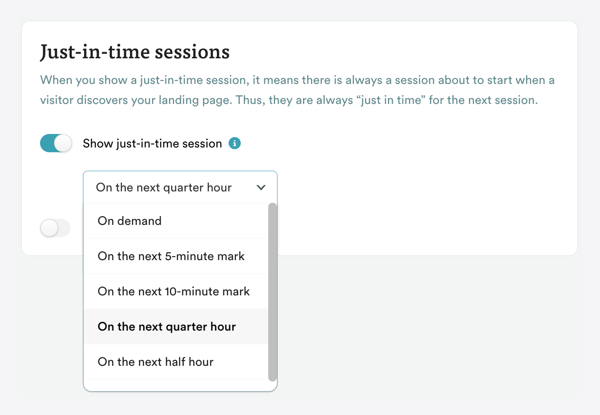 This feature makes it so there is always a webinar starting within minutes of someone visiting your landing page, so they are always “just in time” for the next session.
This feature makes it so there is always a webinar starting within minutes of someone visiting your landing page, so they are always “just in time” for the next session.
Alternatively, you can make your webinars available on demand.
Either way, this feature makes it so your webinars are available to prospects at a peak moment of interest, when they are most likely to take action.
2. Convenient recurring schedule in the attendee’s local time zone
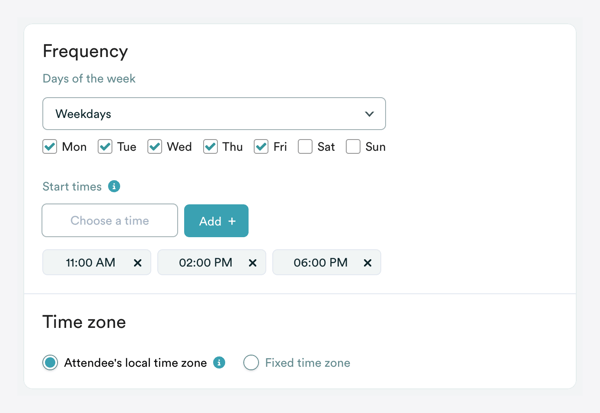 Not everyone will be able to join your webinar right when they discover it. So to avoid risking them leaving and never coming back — and failing to capture the lead — you can offer your webinar on a recurring schedule at convenient times of day in the attendee’s local time zone, whether they are in San Francisco or Singapore.
Not everyone will be able to join your webinar right when they discover it. So to avoid risking them leaving and never coming back — and failing to capture the lead — you can offer your webinar on a recurring schedule at convenient times of day in the attendee’s local time zone, whether they are in San Francisco or Singapore.
That way, they can sign up for a session happening in the next day or so that fits neatly into their calendar.
3. Webinar replays you can sign up for
Most webinar tools only let attendees get a link to watch a webinar replay in a follow-up email after the session they registered for ends. In eWebinar, you can let people register for a replay, so they can just grab the link and go, and watch it later on their own time.
Below is what the sessions in the registration form would look like to someone signing up for a webinar if all three of the features above were enabled at the same time. They could choose to watch a webinar replay, join a just-in-time session starting in just 4 minutes, or choose a convenient time in the next couple of days from the recurring schedule. 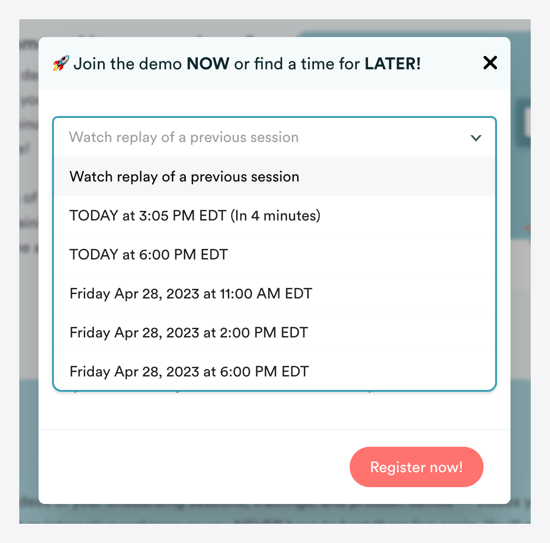
The reason our attendance rates are so high is because we don’t force people to fit our schedule. Instead, we give them lots of options for when (and how) they can watch a webinar. We make it convenient for them so they actually show up!
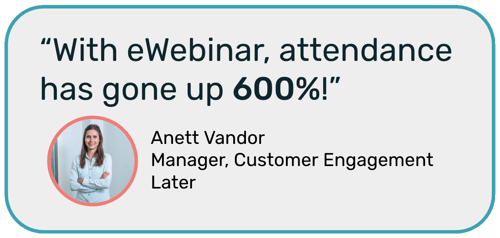
Automated webinars that don’t suck
You may be skeptical and wondering how eWebinar is any better than, say, a video on YouTube or a typical on-demand webinar, which is nothing more than a gated video.
And for good reason! You don’t want to sacrifice the engagement of a live webinar just to make your webinars more available.
This is where eWebinar is different. We are the only webinar platform that lets you put your webinar presentation on autopilot in a way that actually improves the attendee experience.
Our customers regularly report big jumps in their webinar metrics after switching from live webinars to eWebinar. (This is on top of attendance rates that have doubled or more.)
They tell us their watch times have climbed to 90%…
Engagement rates have skyrocketed…
And conversion rates have doubled or even tripled… 
And all this without losing a personal touch. 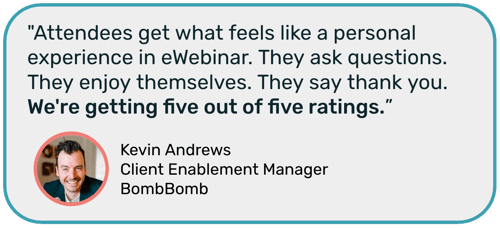
If you’d like to learn how our product makes these numbers possible, join our on-demand demo.
We use eWebinar to demo eWebinar, so you’ll not only get to learn how our product works, you’ll also get to experience it firsthand as an attendee. You can then ask yourself, “Is this the webinar experience I want for my own audience?”
5 bonus tips to maximize webinar attendance
To wrap up this post, we’ll give you 5 bonus tips for how to maximize your webinar attendance:
- Promote your webinar early and often: Start promoting your webinar by sharing your landing page at least two weeks in advance — four to six weeks is better — and use a mix of channels in your webinar marketing strategy, such as email, social media, and blog posts to reach a wider audience of potential customers.
- Send reminders: Schedule three reminder emails to go out a week, a day, and an hour before the webinar to keep your online event top-of-mind for registrants and reduce no-shows.
- Provide incentives: Offering incentives, such as exclusive content, discounts, or giveaways, can increase your webinar registrations.
- Optimize your registration process: A simple and straightforward registration process can help increase sign-up rates. Make sure your registration form is mobile-friendly and only asks for the essential information needed to attend the virtual event.
- Offer an on-demand webinar: This is the only way you’ll ever be able to reach your entire target audience. So at least offer a recording of your webinar after the fact. Just remember, having a pre-recorded webinar does not mean sacrificing engagement, interactivity, or a personal touch — provided you use the right on-demand webinar software, like eWebinar.
Conclusion
Selecting the best time and day to host a live webinar is essential for maximizing attendance rates and achieving your event’s goals.
However, if you wish to explore an alternative approach that could easily double your attendance rates, you may want to give eWebinar a try.
If it sounds too good to be true, join our on-demand demo now to see for yourself!
[ad_2]
Source link



![How to make animated videos? [The Ultimate Guide for Newbies!]](https://wildfireconcepts.com/wp-content/uploads/2022/11/Make-Animated-Videos-1170-x-500-1-440x264.png)





